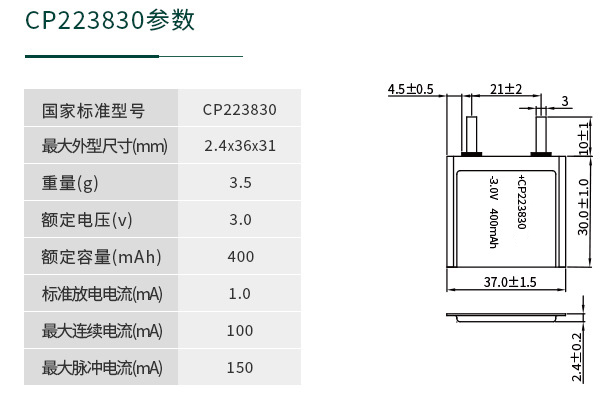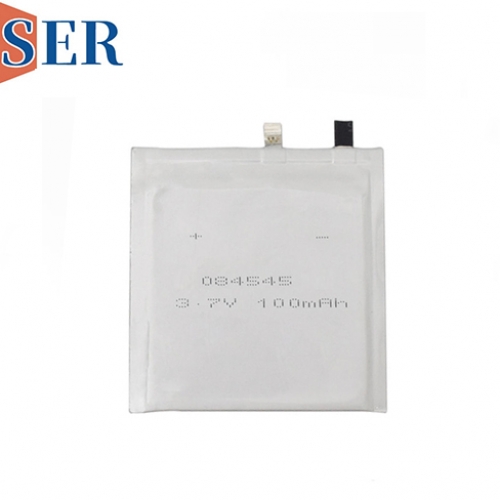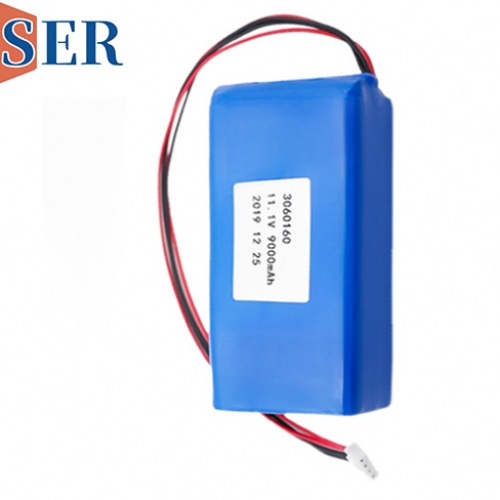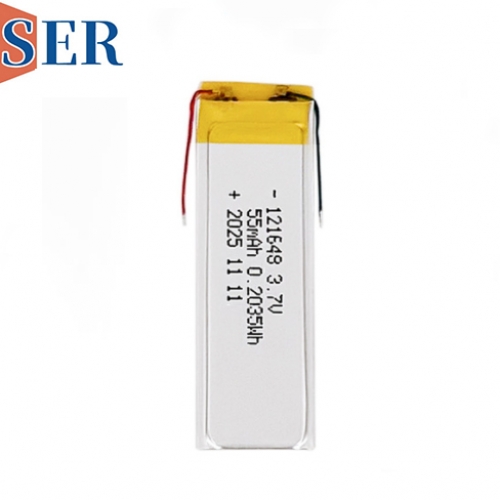Custom Non-rechargeable Pouch Cell LiMnO2 Battery CP223830 for Wearable Devices
Custom Non-rechargeable Pouch Cell LiMnO2 Battery CP223830 for Wearable Devices

The rapid advancement of wearable technology has necessitated the development of efficient, compact, and reliable power sources. Among various battery technologies, the Custom Non-rechargeable Pouch Cell LiMnO2 Battery CP223830, with a voltage output of 3.0V and a capacity of 400mAh, stands out as a promising candidate for powering wearable devices. This article delves into the technical specifications, design considerations, applications, advantages, and challenges associated with this battery type, providing insights into its suitability for modern wearable electronics.
Keywords: LiMnO2 Battery, Non-rechargeable Pouch Cell, Wearable Devices, Battery Technology, Custom Design
Introduction
Wearable devices, such as smartwatches, fitness trackers, medical implants, and augmented reality glasses, have become integral parts of our daily lives. These devices require compact, lightweight, and energy-efficient power sources to maintain prolonged operation without frequent replacements or recharges. The Custom Non-rechargeable Pouch Cell LiMnO2 Battery CP223830, with its specific voltage and capacity characteristics, addresses these requirements by offering a tailored solution for wearable technology applications.
Technical Specifications of CP223830 Battery
2.1 Voltage and Capacity
The CP223830 battery operates at a nominal voltage of 3.0V, which is well-suited for many wearable devices that require a stable power supply within this range. With a capacity of 400mAh, this battery can deliver sufficient energy to power wearable electronics for extended periods, depending on the device's power consumption.
2.2 Chemistry and Design
The battery utilizes Lithium Manganese Dioxide (LiMnO2) chemistry, known for its high energy density, safety, and reliability. The pouch cell design allows for flexible form factors, making it easier to integrate into compact wearable devices without compromising on performance or aesthetics.
2.3 Dimensions and Weight
The custom nature of the CP223830 battery means that its dimensions and weight can be tailored to fit specific device requirements. This flexibility is crucial for wearable technology, where space and weight constraints are significant design considerations.
Design Considerations for Wearable Devices
3.1 Form Factor Integration
Integrating a battery into a wearable device requires careful consideration of the device's form factor. The pouch cell design of the CP223830 battery allows for easy integration into various shapes and sizes, enabling designers to create sleek and ergonomic wearable devices.
3.2 Safety and Reliability
Safety is paramount in wearable devices, especially those that come into direct contact with the user's body. The LiMnO2 chemistry of the CP223830 battery offers inherent safety advantages, such as resistance to thermal runaway and low self-discharge rates, ensuring reliable and safe operation over the device's lifespan.
3.3 Environmental Considerations
With increasing awareness of environmental sustainability, the design of wearable devices must also consider the end-of-life disposal of their components. Non-rechargeable batteries like the CP223830, when properly disposed of, can be recycled to recover valuable materials, reducing their environmental impact.
Applications of CP223830 Battery in Wearable Devices
4.1 Smartwatches and Fitness Trackers
Smartwatches and fitness trackers require a stable power supply to monitor and record various health metrics, display notifications, and run applications. The CP223830 battery's 3.0V voltage and 400mAh capacity make it an ideal choice for these devices, providing sufficient power for extended use without frequent battery replacements.
4.2 Medical Implants
Medical implants, such as pacemakers and glucose monitors, require long-lasting and reliable power sources. The CP223830 battery's high energy density and safety features make it a suitable candidate for powering these life-saving devices, ensuring continuous operation and patient safety.
4.3 Augmented and Virtual Reality Glasses
Augmented and virtual reality glasses are emerging as the next frontier in wearable technology. These devices require high-performance batteries to support their complex processing and display capabilities. The CP223830 battery's custom design and high energy density make it a viable option for powering these advanced wearable devices.
Advantages of CP223830 Battery
5.1 High Energy Density
The LiMnO2 chemistry of the CP223830 battery offers a high energy density, allowing it to store more energy in a smaller and lighter package. This is crucial for wearable devices, where space and weight are at a premium.
5.2 Safety and Reliability
The inherent safety features of the LiMnO2 chemistry, combined with the pouch cell design, ensure reliable and safe operation of the CP223830 battery in wearable devices. This reduces the risk of battery-related failures and enhances user safety.
5.3 Customizability
The custom nature of the CP223830 battery allows for tailoring its dimensions, capacity, and other specifications to meet the specific requirements of different wearable devices. This flexibility enables designers to create optimized power solutions for a wide range of applications.
5.4 Cost-Effectiveness
While the initial cost of custom batteries may be higher than off-the-shelf options, the long-term benefits, such as improved device performance, reduced maintenance costs, and enhanced user satisfaction, can outweigh the initial investment. Additionally, the ability to source batteries in bulk quantities can further reduce costs and improve supply chain efficiency.
Challenges and Considerations
6.1 Non-rechargeability
One of the main limitations of the CP223830 battery is its non-rechargeable nature. This means that once the battery is depleted, it must be replaced with a new one. While this may be acceptable for some wearable devices with low power consumption or long replacement intervals, it can be inconvenient for devices that require frequent use or have high power demands.
6.2 Environmental Impact
Although non-rechargeable batteries can be recycled, their disposal still poses environmental challenges. It is essential to ensure proper recycling and disposal practices to minimize the environmental impact of these batteries.
6.3 Temperature Sensitivity
Like all batteries, the CP223830 battery is sensitive to temperature changes. Extreme temperatures can affect its performance and lifespan. Therefore, it is crucial to consider the operating temperature range of the battery when designing wearable devices and to implement appropriate thermal management strategies.
Future Trends and Developments
7.1 Advancements in Battery Chemistry
Ongoing research in battery chemistry aims to improve the energy density, safety, and environmental sustainability of non-rechargeable batteries. Future developments in LiMnO2 chemistry or the emergence of new battery technologies could further enhance the performance of the CP223830 battery and similar products.
7.2 Integration with Energy Harvesting Technologies
To extend the operational lifespan of wearable devices, there is a growing interest in integrating batteries with energy harvesting technologies, such as solar cells or kinetic energy harvesters. This approach could reduce the reliance on battery replacements and improve the overall sustainability of wearable devices.
7.3 Smart Battery Management Systems
The integration of smart battery management systems (BMS) into wearable devices can enhance battery performance, safety, and user experience. BMS can monitor battery health, optimize power consumption, and provide users with real-time battery status information, improving the overall usability of wearable devices.
Conclusion
The Custom Non-rechargeable Pouch Cell LiMnO2 Battery CP223830, with its 3.0V voltage and 400mAh capacity, offers a promising power solution for wearable devices. Its high energy density, safety features, customizability, and cost-effectiveness make it a suitable candidate for a wide range of applications, including smartwatches, fitness trackers, medical implants, and augmented reality glasses. However, challenges such as non-rechargeability, environmental impact, and temperature sensitivity must be carefully considered when designing and implementing these batteries in wearable devices.
As wearable technology continues to evolve, the demand for efficient, compact, and reliable power sources will only increase. The CP223830 battery and similar products have the potential to play a significant role in powering the next generation of wearable devices, enabling new applications and improving user experiences. Ongoing research and development in battery chemistry, energy harvesting technologies, and smart battery management systems will further enhance the performance and sustainability of these power solutions, paving the way for a more connected and intelligent future.





